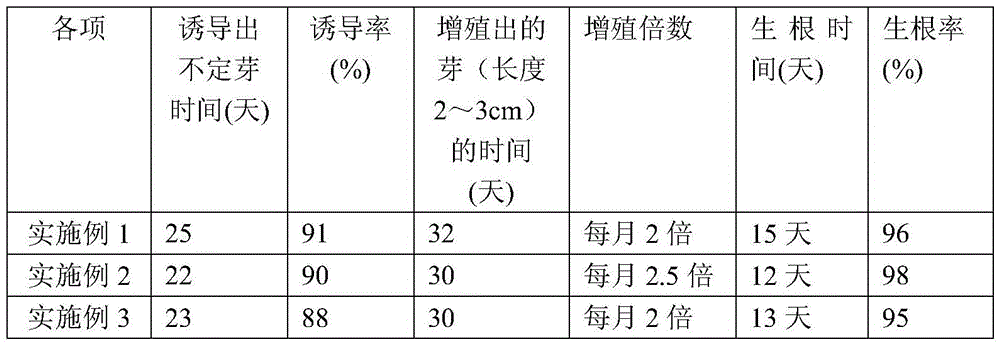A group of rapid propagation medium for vines
A technology for multiplying culture medium and customs clearance rattan, which is applied in the directions of plant cells, horticulture, and botanical equipment and methods, can solve the problems of low seed reproduction rate of customs clearance rattan, susceptibility to diseases of cutting propagation seedlings, long growth cycle, etc. The effect of large-scale production, alleviation of market drug pressure, and high rooting rate
- Summary
- Abstract
- Description
- Claims
- Application Information
AI Technical Summary
Problems solved by technology
Method used
Image
Examples
Embodiment 1
[0017] (1) Selection and treatment of explants
[0018] The explants are derived from the Tongguan vine plant in the wild in Mengzi County, Yunnan Province. The new shoots of the year that are free from diseases and insect pests are selected, and cut into single-bud stem segments with one bud as explants, and are initially sterilized in the following order: Rinse with running water for 2.5 hours, soak in water with a mass fraction of 5% washing powder for 5 minutes, and rinse under running water for 25 minutes; soak the customs-clearing cane section that has undergone preliminary sterilization treatment with a volume fraction of 75% ethanol solution for 1 minute, and then use mass fraction After immersing in 0.1% mercuric chloride solution for 12 minutes, wash with sterile water for 3 to 5 times, and use sterile paper to dry the water on the surface of the cane section for later use.
[0019] Because the twigs of Tongguan vine are densely covered with light yellow fluff, a lot...
Embodiment 2
[0034] Embodiment 2 Except that the following steps are different, the operation of other steps is the same as that of Embodiment 1, and will not be repeated here.
[0035] (1) Selection and sterilization of explants
[0036] The explants came from the wild vine plants of Mengzi County, Yunnan Province, and were transplanted to the new shoots that grew in the same year after domestication in the greenhouse of Yunnan Agricultural University. Other disinfection treatment steps are consistent with the explant treatment method in Example 1, the difference is that the disinfection time is 11 minutes with a mass fraction of 0.1% mercuric chloride solution, which can achieve the lowest pollution rate and high survival rate.
Embodiment 3
[0038] Embodiment 3 is the same as that of Embodiment 1 except that the following steps are different, and will not be repeated here.
[0039] (1) Selection and sterilization of explants
[0040]The explants are derived from the Tongguan vine plants in the wild in Maguan County, Yunnan Province. The young shoots of the year that are free from diseases and insect pests are selected and cut into single-bud stems with one bud as explants. The mass fraction is 0.1% mercuric chloride When the disinfection time was 12 minutes, the pollution rate reached the lowest and the survival rate was high. Its disinfection time is consistent with that of the explants in Example 1 from Mengzi County, Yunnan Province, which is related to the fact that the explants are all from the wild and have a lot of dust and germs on the plants.
[0041] See Table 2 for the test results of Embodiment 1 to Embodiment 3.
[0042] The test effect of table 2 embodiment 1-embodiment 3
[0043]
[0044] Thro...
PUM
| Property | Measurement | Unit |
|---|---|---|
| induction rate | aaaaa | aaaaa |
Abstract
Description
Claims
Application Information
 Login to View More
Login to View More - R&D
- Intellectual Property
- Life Sciences
- Materials
- Tech Scout
- Unparalleled Data Quality
- Higher Quality Content
- 60% Fewer Hallucinations
Browse by: Latest US Patents, China's latest patents, Technical Efficacy Thesaurus, Application Domain, Technology Topic, Popular Technical Reports.
© 2025 PatSnap. All rights reserved.Legal|Privacy policy|Modern Slavery Act Transparency Statement|Sitemap|About US| Contact US: help@patsnap.com


